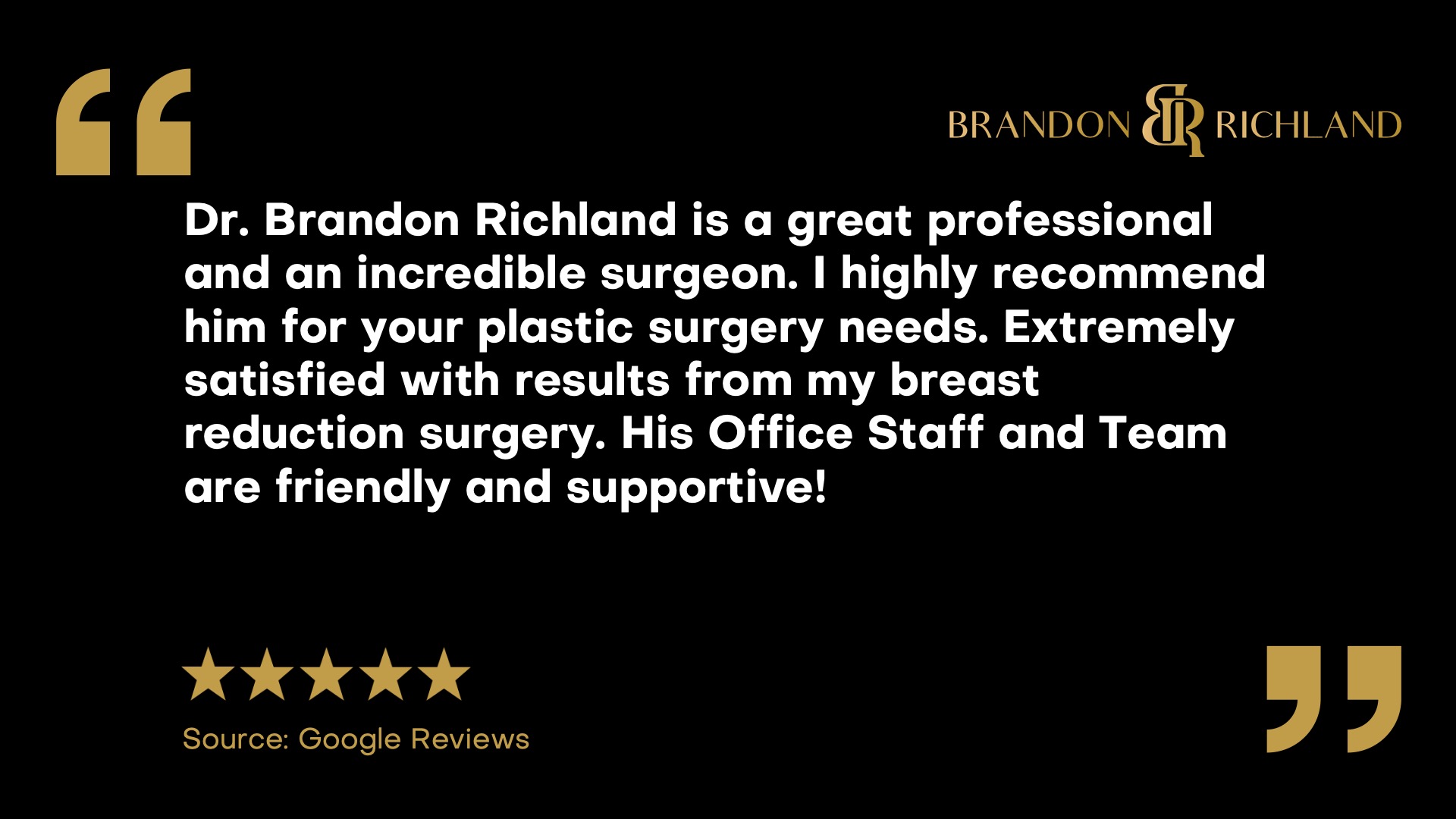Published by Dr. Brandon Richland, MD

“Dr. Brandon Richland is a great professional and an incredible surgeon. I highly recommend him for your plastic surgery needs. Extremely satisfied with results from my breast reduction surgery. His Office Staff and Team are friendly and supportive!”
Read the full Google Review here.
Understanding Breast Reduction Surgery
Breast reduction surgery is a procedure aimed at reducing the size and weight of large breasts to alleviate discomfort and improve quality of life. The surgery involves the removal of excess breast tissue, fat, and skin.
Overview of Breast Reduction
Breast reduction, medically known as reduction mammaplasty, is a surgical procedure for individuals seeking relief from the physical and emotional burdens of overly large breasts. The surgery entails the removal of excess breast tissue, fat, and skin to achieve a breast size proportionate to the individual’s body.
Candidacy and Goals
Individuals who are candidates for breast reduction generally suffer from physical symptoms like back pain, shoulder pain, skin irritation, and rashes due to the weight of their breasts. Women with sagging and breast pain, as well as men with gynecomastia, may pursue this surgery. Goals include improved quality of life, enhanced self-esteem, and relief from discomfort.
Breast Anatomy and Size Considerations
Breast size is determined by the volume of breast tissue, fat, and skin. In breast reduction surgery, a surgeon assesses these components, as well as the nipple’s position and the breast’s natural contour. An optimal outcome preserves function and offers a symmetrical and aesthetically pleasing result.
Common Reasons for Undergoing Surgery
Many individuals opt for breast reduction surgery to resolve functional issues and improve personal aesthetics. Functional reasons include persistent back, shoulder, and breast pain, difficulty engaging in physical activities, and complications like rashes or skin irritation beneath the breast fold. From an aesthetic perspective, smaller, firmer breasts may reduce the appearance of sagging and can help clothing fit better.
Preparing for Breast Reduction Surgery
Breast reduction surgery necessitates a series of preparatory steps to ensure patient safety and the best possible outcome. These steps involve consultations, medical evaluations, understanding potential risks, and adhering to specific preoperative instructions.
Initial Consultation with Surgeon
The journey to breast reduction surgery begins with a comprehensive initial consultation. During this meeting, the patient discusses their medical history and desired outcomes with a board-certified plastic surgeon. It is an opportunity to address any concerns and ask questions. The surgeon will take detailed photos for medical records and discuss the surgical plan. They may suggest adjusting certain lifestyle practices, such as smoking, which can affect both skin healing and blood flow.
Medical Evaluations and Mammogram
Prior to surgery, patients undergo thorough medical evaluations to assess their overall health. This includes a mammogram to rule out breast abnormalities. The patient should disclose all current medications to the surgeon, as some substances, like aspirin, anti-inflammatory drugs, ibuprofen, and acetaminophen, may increase the risk of bleeding and should be avoided.
Understanding Risks and Setting Expectations
Understanding the potential risks and setting realistic expectations are essential for a successful surgery process. The doctor will explain complications related to anesthesia, including general anesthesia, and specific risks associated with the surgery itself, like changes in skin sensation. The patient should have a clear understanding of the recovery timeline and the anticipated appearance of their breasts post-surgery.
Pre-Surgery Instructions
Before the day of surgery, patients receive a list of pre-surgery instructions. These may include guidance on choosing loose-fitting clothing that is easy to put on after the procedure. The surgeon might also advise fasting for a specific period before administering anesthesia. Adhering to these instructions is vital for minimizing the risk during surgery and aiding in a smooth recovery.
The Surgery and Recovery Process
Breast reduction surgery, or reduction mammoplasty, is intricately designed to help patients achieve a breast size in proportion with their body, oftentimes alleviating discomfort associated with overly large breasts. The process involves anesthesia, precise incisions, the removal of excess tissue, and careful postoperative care to ensure the best possible outcome with minimal complications.
Anesthesia and Incision Techniques
Patients are typically given general anesthesia before the surgery begins, ensuring they are asleep and unaware during the procedure. Surgeons utilize various incision techniques depending on the amount of reduction required and the patient’s specific anatomy. Common incision patterns include:
- Around the areola
- Vertical incision from the areola to the breast crease
- Inverted T or anchor-shaped incision
The choice of technique directly affects the final appearance of scars and the overall healing process.
Reduction Mammoplasty Procedure
During the procedure, the surgeon removes excess breast tissue, fat, and skin to reduce the size of the breasts. In some cases, liposuction may be incorporated to remove additional fat from the underarm area. The nipple and areola are often repositioned to a more natural height, and the areola size may be reduced to complement the new breast size. Care is taken to maintain nipple sensation and blood supply for future breastfeeding when possible.
Postoperative Care and Healing
After surgery, patients are typically dressed with gauze, a surgical bra, and sometimes drainage tubes to remove excess fluid. The initial recovery period can involve swelling, bruising, and discomfort, which are managed with medication and careful monitoring.
- Patients must avoid strenuous physical activity for at least 4-6 weeks.
- Care instructions often include the use of ice to help with swelling and sleeping in an elevated position.
Managing Side Effects and Complications
Common side effects such as pain, numbness, and discomfort around incision sites can be expected, but if signs of infection or abnormal bleeding appear, patients should contact their surgeon immediately. Long-term care includes monitoring for:
- Scarring: patients might see a decrease in scar appearance over time.
- Seroma: a collection of fluid that may need to be drained by the surgeon.
Medications and ointments can be prescribed to manage any pain or reduce the risk of infection.
Life After Surgery and Long-Term Care
Most patients can return to work within 2 to 3 weeks post-surgery, depending on their job type. It’s important to continuously assess breast shape and sensation as these can evolve over several months. To maintain the surgery’s benefits, patients should:
- Sustain a stable weight
- Wear supportive bras during exercise
- Plan pregnancies and breastfeeding with a healthcare provider for tailored advice
Long-term satisfaction is high among those who have undergone breast reduction, with improvements in physical activity, appearance, and relief from symptoms like back pain and headaches.
Schedule Your First-Class Cosmetic Consultation with Dr. Brandon Richland, MD
Contact Dr. Richland today by visiting RichlandMD.com, scheduling a cosmetic consultation, or by calling 714-844-0398 or 949-997-2958 directly.











